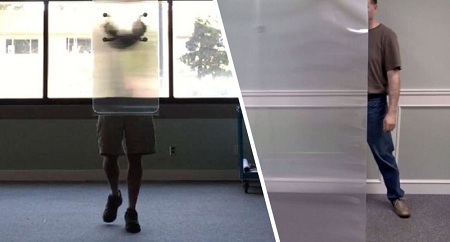Cloth invisible that seem to exist only in fiction can become a reality on the battlefield. The potential of stealth technology is being tested as the British military is tasked with testing an invisibility cloak that would allow them to blind enemies on the battlefield.
Thank you for reading this post, don't forget to subscribe!Invisible Cloth: British Army’s Breakthrough
In field testing at Fort Benning, Georgia, USA, soldiers from the 3rd Infantry Battalion used a camouflage sheet called Vatec. They use this type of material that can change shape to suit the terrain to pretend to be camouflaged “enemy soldiers” on the battlefield. Test participants reported not seeing the “enemy”, even when using infrared trackers and the latest heat detection devices.

The materials to create Cloth invisible were originally developed by researchers from the Massachusetts Institute of Technology (MIT) and the University of Illinois. Its superior characteristic is that it transforms in accordance with the surrounding environment, similar to the special abilities of molluscs such as octopuses and squids.
Organisms with skin rich in melanocytes can change color to match external factors in the presence of predators. The research team has developed a process that mimics this ability using Visual Appearance Modulation technology.
The studied material has one side containing small light-sensitive cells, sensitive to the color of the environment. Once a color is detected, an electrical signal activates the top layers to mimic that color using a heat-sensitive dye, and the process happens quickly in about two to three seconds.
Color-changing technologies could be applied within the next five years to camouflage military vehicles and soldiers on the battlefield.
Advancements in Stealth Materials: Securing the Future of Military Technology
Stealth materials represent a promising frontier in both defense and materials science industries. Engineered to reduce the detectability of objects by radar systems, stealth materials make it challenging for them to be identified or tracked. These materials find extensive use in the manufacturing of military assets such as aircraft, naval vessels, and spacecraft.

Common stealth materials include substances containing carbon and polymers with radar-absorbing capabilities. When radar waves encounter these materials, they are absorbed rather than reflected, diminishing the likelihood of detection. Nanomaterial technologies also play a pivotal role in the development of efficient stealth materials.
For the military, the primary advantage of stealth materials lies in their ability to enhance concealment, providing protection and increased safety during military operations. With ongoing advancements in material research, the defense industry continually strives to develop increasingly effective and sophisticated stealth solutions.
While we may not be seeing invisibility cloaks like those in Harry Potter anytime soon, there’s no denying the advances made in this field are impressive. Ongoing research and collaboration between scientists, engineers and materials experts promises further breakthroughs in the future. Stealth technology could one day become an integral part of our lives, revolutionizing various industries and changing the way we view the world.





